
MARS PARROTOPIA REVISITED
Report #167
August 16, 2009
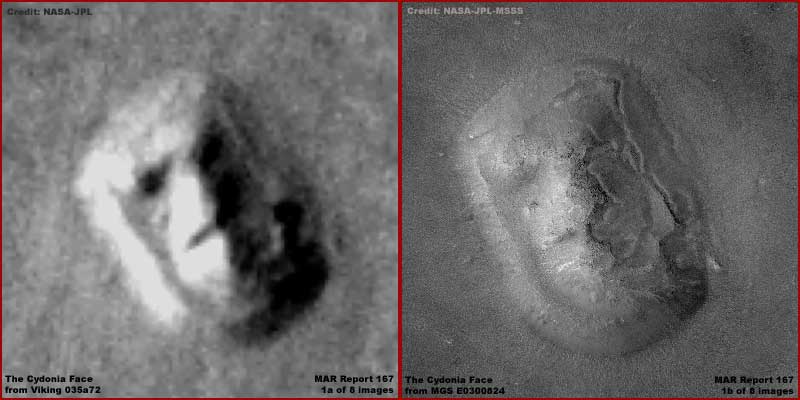
More visuals & discussion of the above Cydonia Face
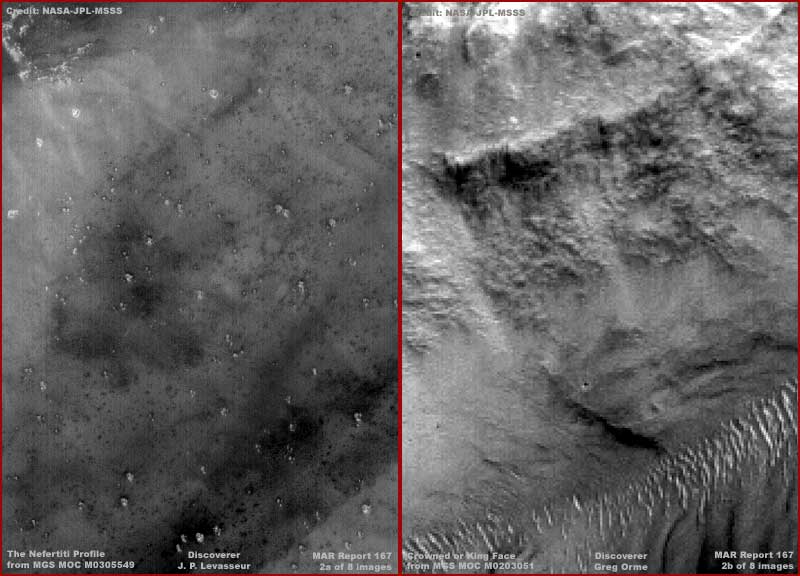
More
on the above Nefertiti Profile-1 ............................................
More on the
above Crowned or Kings Face-1
More
on the above Nefertiti Profile-2 ............................................
More
on the above Crowned or Kings Face-2
The above first and second split screen
images are reminder visuals of anomalous Mars terrain relief type evidence
discovered by others that have become well known over the years. Many of you
have seen them before on various websites. If not, the above links will take
you to better images and discussions of their subject matter. All have been
the subject of scrutiny and controversy and you must decide for yourself whether
they have any merit. They are included here as samples and examples of various
terrain relief type older evidence from an era that extends from the Viking
data forward through to and inclusive of the MGS MOC data.
What you may not be fully aware of is that there is another lesser known Parrot
land form discovery by Wil Faust he refers to
as Parrotopia that shares this same general past
time line. It does not have quite the fame of the others. That may be because
Wil Faust did not have his own Web presence at the time. Further, he died
not too long after this discovery and the attention seems to have gone away
with his passing. It may also be because of some perceived improbability of
such a discovery on Mars and it just being considered too incredible to be
true and therefore likely fake.
However it is not a fake but true imagery in MGS MOC M14-02185
initial release and the subsequent re-release 8/22/05 MOC2-1191
science data. I was aware of this discovery long ago but didn't take it seriously
at first because it just seemed too fanciful and I was pressed for time. Then
a year or so ago, I took a closer look and found that there was more to this
than first meets the eye. I intended to report on it myself some time ago
because of other evidence at this discovery site likely missed by Faust and
others but just kept putting it off or more to the point forgetting it.
Then a viewer Victoria Brown, who loves Parrots and has many of her own, recently
brought it back to my attention. Her enthusiasm motivated me to get my report
out on this and so here it is as follows.
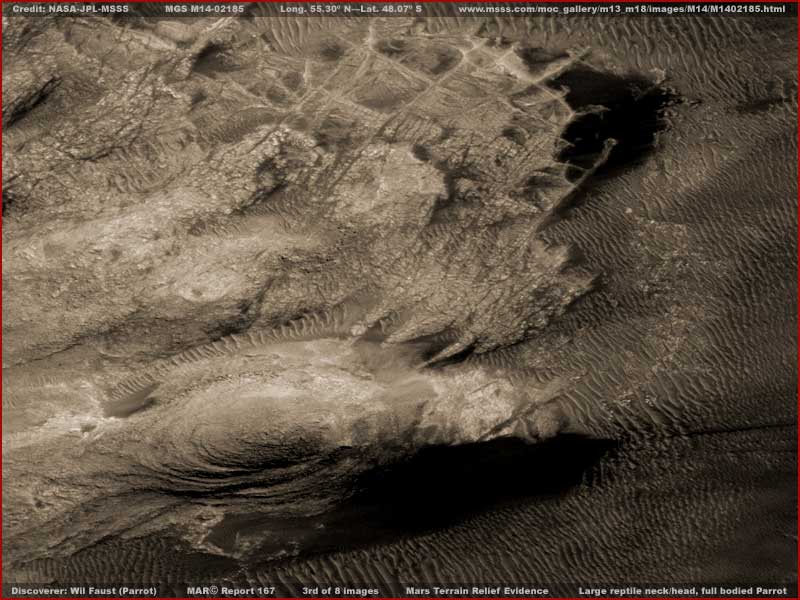
http://www.msss.com/moc_gallery/m13_m18/images/M14/M1402185.html
http://viewer.mars.asu.edu/planetview/inst/moc/M1402185#start
A larger file size .tiff image is available at the above
second link
The above third image demonstrates the
entire context evidence scene as verified in the official MGS MOC M14-02185
science data at the links above from one side of the original strip to the
other. At this location the first two listed angled strips have the evidence
flipped horizontally but not vertically while the second two listed straight
strips have the evidence flipped vertically but not horizontally relative
to the above orientation. So, if you use the MSSS source and the (3.21 MB)
.gif image, flipping of the image will have to be done to match the above
orientation.
On the other hand, the parrot evidence is in the lower portion of the available
larger size (14.2 MB) .tiff image with its head
to the right and tail to the left in the orientation you see here at the above
second link and this is the image I used to develop my imaging from here.
You should know that, at the second above link, the .jpeg and PDF images also
work just fine and have the same orientation. However the also available .gif
image is full of artifacts and too messy for use.
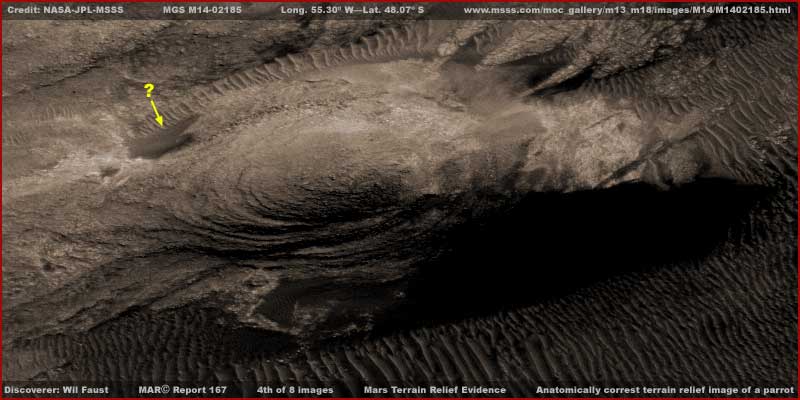
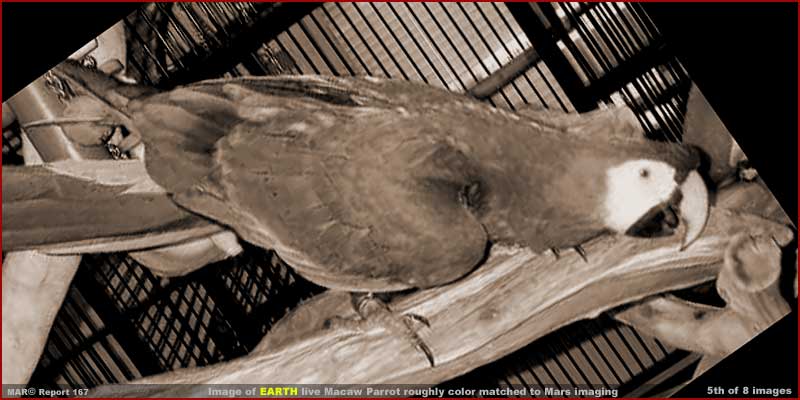
http://avalonaviary.com/scarlet-macaws.aspx
The above fourth image visually isolates
the Mars parrot elevated land form figure and excludes the other site information
that tends to confuse the eye. Can you see the Parrot better now in this image?
If you aren't familiar with what Macaw type parrots look like from upper profile
right side view, the above fifth comparison image of an Earth Macaw parrot
should help some. As you can see, except for very slight differences in posture,
the resemblance between the Earth parrot and Mars parrot figure is striking.
Note that the Earth parrot image was originally in full color but I've taken
that color out and roughly color match to the Mars parrot evidence. I did
this so that the two images can be more easily compared without the Earth
parrot's bright colors flooding and distracting the eye but that's all I've
done.
One difference is that the Mars parrot's right wing is more closed and flush
to the body exposing the upper portion of the right leg while the Earth parrot's
right wing is typically partially open and dropped just a bit hiding the upper
portion of the right leg. Another is that on the Earth parrot's right foot
the outside right toe of the front three appears to be bent backward serving
as an additional back toe or talon. Some Earth parrots are like this. Another
difference is that the Mars parrot's upper beak appears to be a bit bulkier
than the Earth Macaw's upper beak. Otherwise, the comparison is obvious and
remarkable on so many levels.
http://www.m-a-r-s.ws/study3.doc
White paper multiparty study on the many parrot similarity
points
http://www.eclipseedge.org/msgboard/topic.asp?TOPIC_ID=679
Will Faust's personal comments on Parrotopia just before
his death
On the subject of comparison, the above
first link takes you to a 24-page study document on this discovery participated
in by five well known individuals including Wil Faust plus two veterinarians,
all independently illuminating the parrot many points of similarity and their
thoughts on this evidence. No matter how fanciful one's initial reaction might
be, the points are just too many to ignore and pretty much does the job on
the concept of chance terrain configurations and/or fanciful interpretations
leaving only serious evidence as a consideration.
Now I want to draw your attention to an object pointed out by a yellow arrow
and a question mark on the back of the Mars parrot figure in the 4th image.
This appears to be smudge image tampering hiding something there that is casting
a shadow. The shape of the conforming smudge application is suggestive that
this might be hiding an aerial craft landed there but we can't be sure and
that is speculation. But, if so, the question then becomes how does it come
to be there covered over and the artwork itself is not also covered?
I suspect I have an answer for that. You see I strongly suspect that most
of the MGS MOC imaging is taken a much closer resolutions not admitted to
and much of the image tampering is applied at those closer resolutions. Then
the whole is drawn back to a distance hiding a great deal of the manipulation
and that is what is released as the normal resolution.
If so, the much closer view would have been too close to reveal the massive
size artwork outlines. Add to that the fact that the artwork is in this time
frame now very rough in texture and outline. Add to that the strong possibility
that the AI programming may not have anticipated avian artwork on such a large
scale and it didn't meet the programming benchmarks. It's just speculation
but I had to mention this evidence or others would have observed that I missed
this resulting in a bunch of explanations.
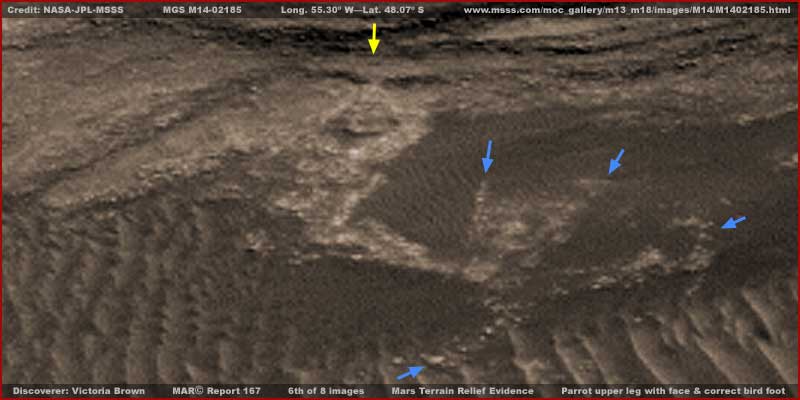
Although out of focus and blurry from
a little too much zoom factor, the above sixth image serves multiple purposes.
For one thing it demonstrates the correct number of toes or talons in their
typical positions on the parrot's right foot on a flat surface ..... one back
and three splayed forward pointed out by the four blue arrows.
Note as well that the upper leg proportions are also anatomically correct
as is the bent backward leg joint separating the upper from the lower leg
typical of birds and parrots. All quite a visual and artistic feat considering
that this is primarily a 2-dimensional rendering rather than a 3-dimensional
figure.
Now here on Earth artwork utilizing land forms in open terrain often involves
multiple artwork subjects. Sure enough note the poorly seen humanoid or primate
facial features located in the upper portion of the leg where it joins the
body as pointed out by the single yellow arrow. It this just a chance landform
anomaly or was this added later as an after thought sort of like graffiti
here on Earth or part of the original design?
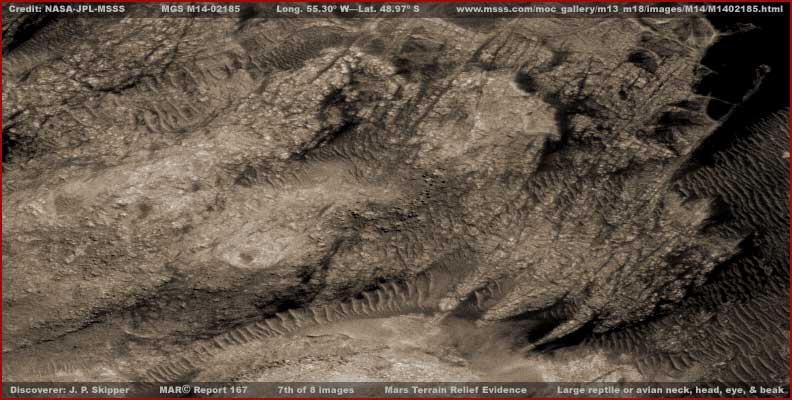
The above seventh image evidence of a
reptilian and/or avian head and neck figure is my own discovery in this general
scene and another deciding factor in my decision to report on this evidence
site. It appears that others missed this evidence every bit as important as
the parrot figure. It is the head and neck of some fierce likely ancient avian
type predator. Note the large eye and elevated eyebrow and the massive sheering
beak. This is consistent with the site's avian theme and likely something
created at the same time as the parrot figure. It could represent an avian
creature like an eagle or something larger and more ancient.
Now look just forward and beneath that massive beak and you will see three
large scale but relatively slender claw like projections all pointing in the
same direction back toward the rear of the avian predator. This may be just
natural landform. On the other hand, considering the rest of the site, it
may be that at one time there may have been a lower level recognizable creature
figure wrapping around and above this avian predator object that was a part
of this artwork but has over time collapsed and crumbled away with only parts
of it now visible and is now no longer recognizable, at least in the part
we can see here. If we could have had more view to the left where the strip
cut off, we might have seen more recognizable forms.
On the other hand, note the geometric rectangular shaped grid like formations
to the right and above the avian predator's head seen in the 3rd image above.
This evidence may have been interpreted as building structures by others early
on but I'm not sure of that? However, they appear to me to likely be old excavations.
The low elevated ridges defining the rectangular formations perimeters are
very indicative of raised access roads accessing and enabling the excavations.
If so, the question becomes whether this is also an old mining site or an
old archeological dig site or both?
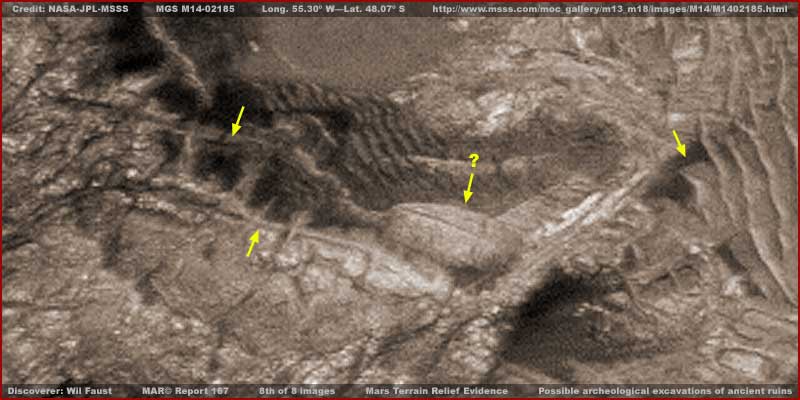
It may be that what we are looking at
in the geometric web areas are old long abandoned archeological excavations
of a much older site. The excavations on a loose grid system have partially
revealed some possible ancient ruins and/or plumbing systems that were in
use when water levels were much higher in the lowland areas of this place.
The best of this type of evidence is demonstrated in the above eighth image.
What needs to be understood is that everything here is very old and long abandoned
but likely also at different times. The artwork is getting more and more visually
rough both from age, erosion by the elements, and growths growing on it. Note
that the lowlands around the site are filled with what I refer to as "ridge
form" growth evidence. This kind of evidence represents some kind of
unknown to us invasive life and it only forms where there is consistent shallow
water presence.
The lower level areas of this place where the ridge forms are the most prevalent
likely represent an old water site that had more pronounced water levels in
older times. As the low areas fill with this life presence taking advantage
of residual water presence, there is a tendency for it to spread out onto
higher dryer terrain where it does more poorly but still visually distorts,
covers and hides other evidence from view. For example, look in the right
margin/center of the above 8th image. Note the end of a very large perfectly
rectangular block visible there pointed out by a yellow arrow strongly suggesting
artificiality that is being covered over by the ridge forms.
Likewise, in the left and center areas, note what are very suggestive of old
rectangular foundations and possible piping lines or old wall ruins pointed
out by yellow arrows. It is possible that in ancient times there was a mining
operation going on here at this site to create the artwork elevated landforms
complete with support facility structures and much later after the site had
all been long abandoned, someone else came along treating the site as an archeological
dig site and then that too as been long abandoned.
It should also be noted that, back in the time when this artwork was in its
best condition, it was and is too large on elevated land forms to be properly
viewed close up or from any where at ground level. This is especially true
of the avian predator figure. That means that the whole was meant to be viewed
from a distance above in the atmosphere in ancient times.
That also suggests it was meant to be seen by someone with enough intelligence
and technology to be present in the atmosphere to see it in those ancient
times on Mars with all the implications.
One thing is for sure, even though all of this is now poorly seen in the present,
at least in the poor imaging supplied to us, the full bodied parrot figure
just has too many anatomically correct points about it in relation to an Earth
Parrot to be chance terrain configurations. It stretches that concept considerably.
The avian predator also present in this scene at this same site strains chance
even more.
, Investigator
![]()